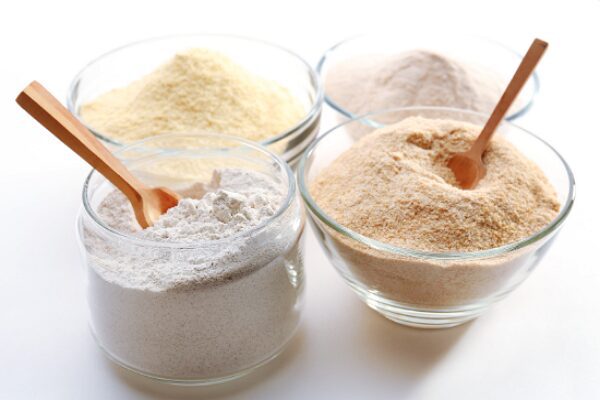Utilizing flour may appear to be a piece of cake. So far, so good, until you arrive at the grocery store and discover that there are hundreds of options. The flour might be all that’s necessary for a basic dish, so it’s essential to decide which sort is suitable. Everything boils down to if you want to increase nutritious advantages or follow an eating constraint or not. Be at ease! To help you, I’ve done some research. The following is a list of all types of flour and their uses that I’ve collected for ourselves. Let’s dive in!
All-Purpose Flour
The first one to be on my list is the household name of all-purpose flour.
Indeed, it’s among the best-selling types nowadays. For instance, if a dish asks for “flour” with no further indication, it means all-purpose. Typically, people produce this from a blend of soft and hard wheat grains which explains its 10 – 12% of protein.
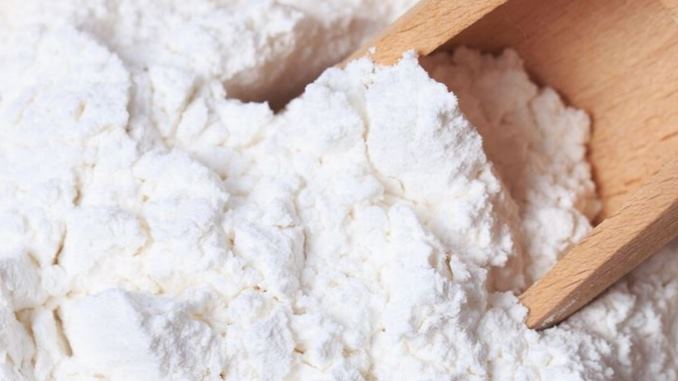
As its name claims, it is the most multi-purpose ingredient by far. You can utilize this ingredient to produce crisp pastry crusts, airy cakes, and dense bread loaves. That’s also why all-purpose flours have become a classic among staples.
Nowadays, this one is available in both bleached and unbleached variants; these 2 are essentially equivalent, although it’s preferable to adapt the thing to the formula.
Almond Flour
Moving on is one of the healthiest types: Almond flour.
This type is flour made from ground, blanched almonds. To make this specific type, you must first separate the shells and the almonds by giving them a quick blanch. After that, grind and filter the separated interior until the final result reaches a fine flour-like texture.
This is excellent for coating seafood, poultry, and even veggies (carrots, celery, and parsnips). Dip your desired ingredients in beaten eggs before coating (for a better stay), and then deep-fry in oil. Sometimes, people can use this as an aromatic and crispy garnish in savory dishes like macaroni and cheese or greens.
At the same time, it can also substitute for others when it comes to pastries and desserts. Just search for the equivalent ratio, and you’re good to go. This gluten-free, low-carb, nutrient-packed type would be just the right thing for people with dietary concerns or specific eating limitations (diseases or allergies).
Related:
Cake Flour
Next on this list is cake flour, featuring the least amount of protein (5 – 8%). However, this one is fantastic for delicate baked products, including cakes (obviously), cookies, cupcakes, and wedges due to its absence of gluten-forming components.

It usually undergoes chlorination, a bleaching procedure that significantly lowers natural gluten proteins and, most importantly, changes starches in this so that it can soak up more liquids and sweeteners. That’s why this type works best to prevent dry and flaky pastries compared to other products.
Related:
Pastry Flour
Pastry flour is approximately at the midpoint of cake flour and all-purpose ones regarding protein content. Indeed, this soft-wheat-made ingredient only contains 8 – 9% of protein.
This one is excellent for pastries, desserts, and numerous delicacies because of its balanced proportion of flakiness and softness. If going to the store to get a new package is way too much for you, you may prepare your homemade pastry flour by combining 1⅓ cups of all-purpose with ⅔ cup of cake flour.
Bread Flour
As the toughest flour, this one boasts a protein level of 12 – 14%. The reason for this is simple: If you want to confine the CO2 gas created throughout development in the yeasted dough, a robust gluten structure is necessary.
Plus, the additional protein leads to a crispier exterior and improved density. Unbleached and bleached flours are both available. If you’ve run out of bread flour, replacing it with unbleached all-purpose ones still offers you desirable results.
Self-Rising Flour
Self-rising flour is those in which people mix baking powder and salt in the milling process. As this low-protein type utilizes wheat cultivated in the South as its main ingredient, many believe it originates from the South. Thus, it has also been a favorite in the region for a long time.
If you’re aiming to bake a cupcake or a cookie, this is the one for you.
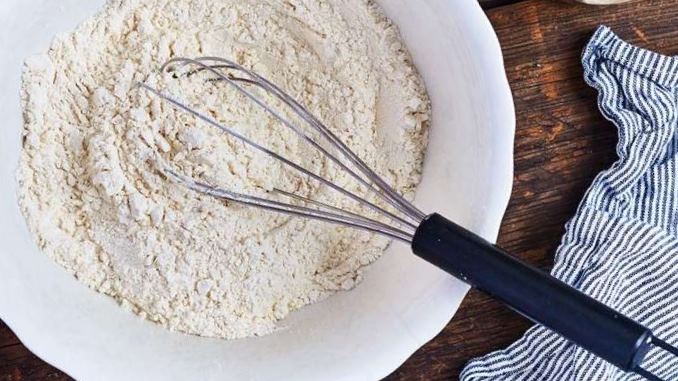
When it comes to storage, keep self-rising flour in its initial packaging and utilize it within 6 months after buying for the best use.
As mentioned above, you can also prepare your homemade self-rising flour effortlessly by mixing 1 cup of pastry flour with 1½ tsp of baking powder plus ¼ tsp of salt.
Whole-Wheat Flour
Throughout mills, people break the wheat kernel into 3 significant parts: the endosperm, the seed (the embryo), and the peel (the external shell). Then, they will add different quantities of germ and bran back to the fine mixture to make whole-wheat flour.
Naturally, this one is abundant in protein. However, its bran and germ limit gluten formation, the leading cause of whole-wheat flour producing less rise and thicker, denser bakery products. Also, it is possible to replace up to 1⁄2 of the all-purpose type using whole-wheat ones in everyday dishes.
As a result of the significant oil content in wheat germ, whole-wheat one can not last as long as other flour. Usually, it will work just fine in normal room conditions for up to 3 months before you need to store them in the freezer.
White Whole Wheat Flour
There’s a difference between this and the above ones. Although people still use the same 3 parts of the wheat kernel: husk, embryo, and endosperm to produce this flour, the used wheat head variety is the lighter white winter wheat seed head. Due to the ingredient’s brighter shade and somewhat sweeter flavor (compared to the whole-wheat above), baked goods using this flour are the perfect choice for cookies, bread, or muffins.
However, similar to the thick and dense result you receive from whole-wheat flour, white whole-wheat ones aren’t suitable for airy, spongy, light cakes. It also contains 13-14% protein content, making it exactly like the regular whole-wheat ones.
Gluten-Free Flour
Nowadays, gluten-free flours are accessible in a broad range of grains, nuts, and starches. Notably, there are a variety of rice flour-based products on the market, including those made from tapioca plus potato starch.
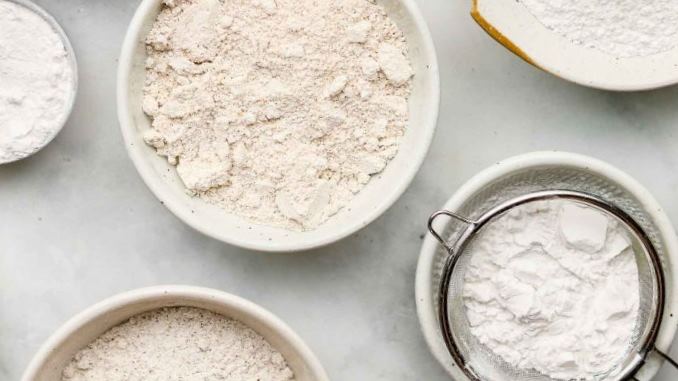
If you want to copy the chewy texture of gluten, xanthan gum is frequently the solution. Follow the detailed instructions or package of the flour for more instructions on replacing wheat flour in your preferred baked products with gluten-free ones.
Vital Wheat Gluten Flour
Vital wheat gluten flour is what we usually call “Super flour” as it only contains minimal starch and high levels of gluten.
Though it’s not 100% flour, hydrated wheat flour is the main ingredient in making this. This hydrated mixture will trigger the gluten, which people subsequently remove from the flour.
Then, they dry the mixture again and grind it into fine powder. Most of the time, this one acts as an enhancer for low-protein flours, such as rye, whole-wheat, or sprouted ones.
Sprouted Flour
Sprouted flour is from sprouted seeds, typically containing far greater nutrients than simply white and red wheat. They are excellent options for anybody looking to enhance both flavor and health. However, they might call for a little more experience to handle it effectively.
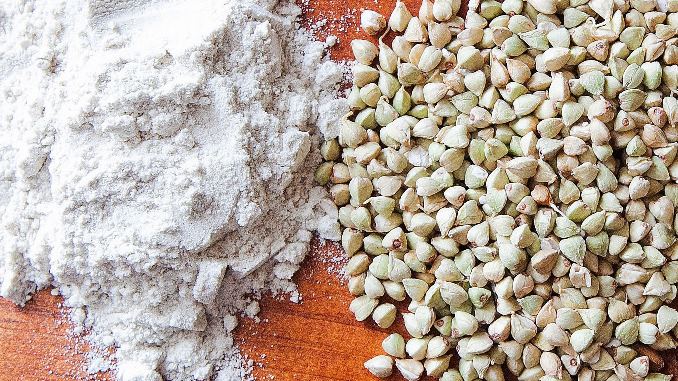
The most frequently-met examples of sprouted flour are rye, corn, sorghum, amaranth, and einkorn, to name a few. As their protein content is dependent on the specific flour, different variants excel at different applications. However, they could work well with any treats like bread, cakes, cookies, or crackers in most cases.
Related: Bisquick vs self-rising flour
Bleached Flour
To get a uniform, pure white shade, people usually bleach the flour using benzoyl peroxide or chlorine following the milling process to eliminate the yellowish tint of carotenoids.
Bleaching causes starches to be highly absorbent while allowing proteins to adhere less firmly together in response to a shift in the starch and protein composition. As a result, the flour becomes less sticky and simpler to deal with in required recipes.
Semolina Flour
Semolina flour is made from durum wheat and has a coarse texture.
It is commonly used to make pasta and couscous, providing a firm and chewy texture to these dishes.
Coconut Flour
Coconut flour is made from dried coconut meat, and it is high in fiber and low in carbohydrates. It is used in gluten-free and low-carb baking for muffins, pancakes, and other baked goods, but it requires additional moisture due to its high absorbency.
What is The Reason Behind the Existence of Various Types of Flour Used in Baking?
The reason behind the existence of various types of flour used in baking is to cater to the diverse needs and characteristics required for different baked goods. As a baker, I understand that each type of flour has its unique properties, such as protein content and texture, which directly influence the outcome of my recipes.
All-purpose flour serves as a versatile option for most baking needs, but for specific creations like bread, cakes, or pastries, I turn to bread flour, cake flour, or pastry flour, respectively, to achieve the desired results in terms of structure, crumb, and tenderness.
The availability of different flours allows me to experiment and fine-tune my recipes, resulting in a wide array of delicious baked treats that satisfy various tastes and preferences.
FAQs
What is the difference between bread flour and all-purpose flour?
Bread flour has a higher protein content than all-purpose flour, which contributes to better gluten development. This makes bread flour ideal for yeast-based bread recipes, as it helps create a chewy and elastic texture in the dough.
What is the difference between whole wheat flour and white flour?
Whole wheat flour is made from the entire wheat kernel, including the bran and germ, providing more fiber and nutrients. White flour, on the other hand, is refined and has had the bran and germ removed, resulting in a lighter texture but with fewer nutrients.
Can I substitute almond flour for regular flour in baking?
Almond flour is gluten-free and adds a nutty flavor to baked goods. While it can be used in some recipes, it’s not a direct 1:1 substitute for regular flour, as it lacks gluten. It’s better suited for gluten-free baking or recipes specifically designed for almond flour.
Can I use coconut flour as a direct replacement for other flour?
Coconut flour is highly absorbent and gluten-free, making it unsuitable for a direct 1:1 replacement with other flours. When using coconut flour in recipes, you may need to adjust the quantity and add more liquid to achieve the right consistency.
What type of flour is best for making pasta at home?
Semolina flour, made from durum wheat, is commonly used for making pasta at home. Its coarse texture provides the perfect consistency and firmness in homemade pasta.
Can I mix different types of flour in a recipe?
Yes, you can mix different types of flour to achieve specific results. Experimenting with flour combinations can lead to unique flavors and textures in your baked goods. Just be mindful of the specific characteristics of each flour type and how they might interact with the recipe.
Conclusion
That’s everything you need to know regarding the available types of flour and their uses. Hopefully, today’s post has cleared the path for you. Happy shopping and cooking!

